Do Neutrinos Crack Nature’s Mirror?
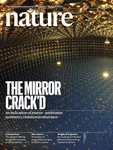
Emeritus Professor John Martin, former professor Hiro Tanaka (now at Stanford) and his senior UofT PhD student Trevor Towstego are among the nearly 500 authors of a Nature paper from the T2K experiment published today, which presents results giving the strongest constraint yet on the so-called CP phase governing the breaking of symmetry between matter and antimatter in neutrino oscillations.
Read the full article here:
https://www.physics.utoronto.ca/news-and-events/news/physics-news/do-neutrinos-crack-natures-mirror/
Theory of Two-Dimensional Nonlinear Spectroscopy for the Kitaev Spin Liquid
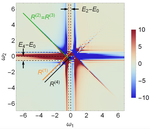
Mr Wonjune Choi and his Ph.D. supervisor Professor Yong Baek Kim proposed a new two-dimensional non-linear spectroscopy method for unambiguous detection of fractionalized particles in quantum spin liquids.
Using the exactly solvable model of quantum spin liquids, they demonstrated that higher-order two-dimensional non-linear susceptibilities would show sharp signatures of Majorana fermions, elusive particles that exist in quantum spin liquids, in contrast to conventional spectroscopic methods. This work is recently published in Physical Review Letters.
The link to the paper is as follows:
https://journals.aps.org/prl/abstract/10.1103/PhysRevLett.124.117205
Magnetic Field Induced Quantum Phases in a Tensor Network Study of Kitaev Magnets

In a recent published article in Nature Communication, a team of researchers from University of Tokyo and University of Toronto led by Professor Yong Baek Kim reported the discovery of a novel quantum ground state in theoretical models designed for the so-called Kitaev magnets in external magnetic field. They used the tensor-network approach, a quantum-information inspired method, to demonstrate the existence of the nematic paramagnet. Such novel ground states break the lattice rotational symmetry spontaneously and may be relevant to a series of remarkable recent experiments done on this class of materials.
Read the full the article here:
Professor Paramekanti and Collaborators Discover New Octupolar Magnets
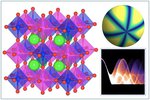
Magnetic solids derive their properties from the magnetic dipole moment of the electrons in the crystal. However, when many electrons interact, they can lead to new types of ordering arising from higher-rank multipole moments.
Read the full article here:
Professor Aephraim Steinberg Explains Quantum Mechanics to Macleans Magazine
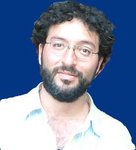
Department of Physics Professor Steinberg was interviewed by Macleans magazine in January 2020.
After decades of experimentation, billions of dollars in investment across the globe and gut-wrenching uncertainty about whether it was even physically possible, we've proven a quantum computer can work.
Read the article here:
Professor Morris was featured on the CBC on Jan 28, 2020 for building an outdoor icicle machine in the backyard of artist Ron Wild
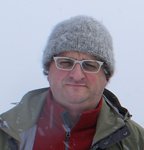
Operating the machine is a project of Ron Wild — a digital artist who considers himself a "citizen scientist" — and his friend and collaborator Stephen Morris, a University of Toronto physics professor who has been studying icicles for many years and compiling findings in an icicle atlas.
Morris typically grows his icicles in his lab, but has also been growing them on his porch for the last two winters, using an outdoor version of the lab machine. This year Morris is away in British Columbia, so Wild has been babysitting — and experimenting.
Read the full article here:
https://www.cbc.ca/news/canada/toronto/icicle-machine-toronto-1.5439862
Visualizing Poiseuille Flow of Hydrodynamic Electrons

In a theory-experiment collaboration, Professor Thomas Scaffidi and colleagues observed for the first time a completely new regime of transport in which the electrons behave like a viscous fluid, flowing down the wire.
The story was also featured in a News and Views in Nature. The experiments were done at the Weizmann institute in the group of Shahal Ilani, and the theoretical calculations were performed at the University of Toronto in the group of Thomas Scaffidi.
Read the full article here:
A Toronto startup with roots at U of T hopes to catch the next big wave in computing
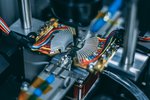
One Toronto-based startup, Xanadu, is betting on a branch of quantum computing known as “photonics,” which harnesses particles of light, or photons, to manipulate quantum information. In its lab on the 29th floor of a downtown Toronto office tower, the company’s scientists work at dust-free tables chock-a-block with lenses, mirrors and fibre-optic cables, manipulating light at the quantum level to encode and process information. More than a dozen physicists at Xanadu have links with the Department of Physics. Some are former graduate students, undergraduate students, or postdoctoral fellows. Others are current graduate students involved in Xanadu’s research. Professor John Sipe is one of the company’s technical advisers.
Read the full article here:
MOPITT – Measuring Pollution in the Troposphere for 20 Years
"This is a Canadian story since the instrument was designed and built in the country. It was then passed to NASA who put it into the Terra satellite and launched it on December 18th, 1999, 18:57:39 UTC.
On that day we had all hoped that ten years of planning were going to successfully pay off. There were five instruments on the satellite, ASTER (Japanese), CERES, MISR, MODIS and MOPITT (Canada). The mission was expected to last five years – and I have always wondered whether the planning people were Trekkies (“These are the voyages of the Starship Terra. Its five-year mission: to explore strange new worlds….”)..."
Read the full article written for the Canadian Meteorological and Oceanographic Society here by Professor Emeritus James Drummond here:
2019 William T. Pecora Team Award
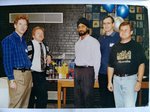
"Professor Emeritus James R. Drummond is a member of the Terra satellite team which received the 2019 William T. Pecora Team Award in early October. The Pecora award is sponsored by the U.S. Department of the Interior and the National Aeronautics and Space Administration. It is presented annually to recognize outstanding contributions by individuals or teams using remote sensing to understand the Earth, educate the next generation of scientists, inform decision makers or support natural or human-induced disaster response.
The citation for this award (https://www.usgs.gov/news/pecora-award-honors-excellence-earth-observation-0) notes that "Terra is arguably one of the most successful Earth-sensing satellites ever deployed." Terra was launched in December 1999 carrying a suite of instruments to study the Earth-atmosphere system. One of these is the Measurement of Pollution in the Troposphere (MOPITT) instrument (https://mopitt.physics.utoronto.ca/).
MOPITT was conceived by Prof. Drummond, funded by the Canadian Space Agency, built by four Canadian companies, and tested in the Space Instrument Characterization Facility in the basement of the Physics Department with the help of a small army of students, postdocs, and technical staff. As noted in the citation, MOPITT was the first instrument "designed to observe the distribution and transport of tropospheric carbon monoxide and, along with other sensors, has helped advance our understanding of air quality and biomass burning emissions."

